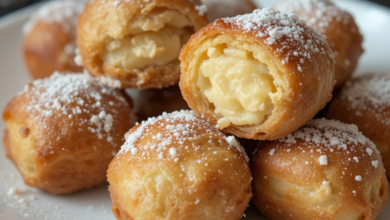Authentic Italian Carbonara Recipe | The True Roman Classic (4 Eggs, 4 Servings)
There’s a magic in simplicity. In the world of pasta, few dishes capture this principle as perfectly as Authentic Italian Carbonara. Creamy without a drop of cream, rich yet balanced, and ready in the time it takes to boil water, this Roman classic is a testament to the power of a few, perfect ingredients. Forget the heavy, cream-laden versions; the true carbonara is an elegant emulsion of egg, cheese, pork, and pepper.
Yet, this iconic dish is also one of the most misunderstood. Its simplicity is its trap every step matters. This guide is your definitive roadmap to creating the perfect, traditional Spaghetti alla Carbonara at home. We’ll demystify the process, ensuring you achieve that legendary silky sauce that clings to every strand of pasta, not scrambled eggs. So, grab your fork and let’s journey to Rome, one perfect bite at a time.

The Holy Trinity of Ingredients: Quality is Key
The authentic carbonara recipe rests on just five core ingredients. There are no substitutes for the main components if you want the true flavor. Each one plays a crucial role.
Serves: 4
Prep Time: 10 minutes
Cook Time: 15 minutes
Total Time: 25 minutes
Core Ingredients (Non-Negotiables):
- 400g (about 14 oz) Spaghetti or Rigatoni: The classic choice is spaghetti, but rigatoni is also beloved in Rome for its ability to hold sauce.
- 150g (5.3 oz) Guanciale: This is the star. Guanciale is cured pork jowl. It’s fattier, more flavorful, and has a better texture than pancetta or bacon. Find it at an Italian deli or specialty market. If absolutely necessary, you can use high-quality pancetta as a substitute.
- 4 large Egg Yolks + 1 whole Egg: This is the heart of the sauce. Using mostly yolks creates an ultra-rich, velvety texture. The whole egg helps bind it. Crucially, they must be at room temperature.
- 150g (1 ½ cups) finely grated Pecorino Romano cheese: This sharp, salty sheep’s milk cheese is traditional. Parmesan (Parmigiano-Reggiano) can be used for a milder taste, or use a 50/50 blend.
- Freshly cracked Black Pepper: Not an afterthought! The heat and aroma of freshly cracked Tellicherry or similar pepper are essential. You’ll use a lot.
Equipment:
- Large pot for pasta
- Large frying pan or skillet
- Mixing bowls
- Whisk
- Tongs
- Grater for cheese

Step-by-Step Guide to Perfect Carbonara
Follow these steps in order, with care. The key is managing heat to create an emulsion, not scrambled eggs.
Step 1: Prepare Your Mise en Place (Everything in its Place)
This dish comes together fast, so preparation is vital.
- Cut the Guanciale: Slice the guanciale into 1/4-inch thick strips (lardons). Don’t make them too small; you want substantial, meaty bites.
- Grate the Cheese: Finely grate all your Pecorino Romano. A microplane is ideal.
- Prepare the Egg Sauce: In a medium bowl, whisk together the 4 egg yolks and 1 whole egg until smooth. Add 100g (about 1 cup) of the grated Pecorino and a very generous amount of freshly cracked black pepper. Whisk until it forms a thick paste. Set this bowl aside near your stove.
- Start the Pasta Water: Fill your large pot with water, add a small handful of coarse salt (it should taste like the sea), and bring it to a rolling boil.
Step 2: Cook the Guanciale
- Place the strips of guanciale in a cold, large skillet or pan. Do not add oil.
- Turn the heat to medium-low. Let the guanciale slowly render its fat and become crisp. This should take about 10-12 minutes. You’re aiming for golden, crispy meat and liquid fat in the pan.
- Once crisp, turn off the heat. Use a slotted spoon to transfer the crispy guanciale to a paper towel-lined plate. Leave the beautiful rendered fat in the pan.
Step 3: Cook the Pasta & The Critical Emulsion
This is where the magic happens. Timing and temperature are everything.
- Cook the Pasta: Drop your spaghetti into the boiling salted water. Cook it for 1-2 minutes LESS than the package instructions indicate. You need it very al dente as it will finish cooking in the pan.
- Reserve Pasta Water: Just before draining, scoop out about 1 ½ cups of the starchy pasta cooking water. This liquid gold is key to the sauce.
- Combine Pasta and Fat: Using tongs, transfer the al dente pasta directly from the pot into the skillet with the rendered guanciale fat. Toss well to coat every strand. The residual heat from the pan is perfect.
- Temper the Eggs: Here is the most crucial step to avoid scrambling. Take a ladle (about 1/4 cup) of the hot pasta water and slowly, while whisking vigorously, drizzle it into the bowl with the egg and cheese mixture. This gradually raises the temperature of the eggs (tempering).
- Create the Sauce: Remove the skillet from any heat source (you can even place it on a cold burner). Quickly pour the tempered egg mixture over the hot pasta. Immediately start tossing and stirring rapidly with tongs. The goal is to use the residual heat of the pasta to cook the eggs into a creamy sauce.
- Adjust Consistency: If the sauce looks too thick or is clumping, add more hot pasta water, a tablespoon at a time, while tossing. You’re looking for a creamy, glossy sauce that smoothly coats the pasta not runny, not sticky.

Step 4: The Final Touch
- Once the sauce is silky and perfect, toss in the crispy guanciale and most of the remaining grated Pecorino Romano.
- Give it one final, gentle toss to combine.
- Serve immediately. Carbonara waits for no one. Plate it up in warm bowls and finish with an extra crack of black pepper and a sprinkle of the remaining cheese.
Pro Tips for Carbonara Perfection (The Roman Way)
- No Garlic, No Onion, No Cream: This is the law. Traditional carbonara does not contain these. Let the guanciale, Pecorino, and pepper shine.
- Room Temperature Eggs are Non-Negotiable: Cold eggs will cool the pasta down too quickly and are more likely to scramble when mixed in.
- Control the Heat: The pan must be off the heat when you add the egg mixture. If you’re nervous, you can let the pasta cool in the pan for 30 seconds before adding the eggs. The residual heat is more than enough.
- The Pasta Water is Your Secret Weapon: It’s starchy, salty, and hot. It’s the magic ingredient that helps emulsify the sauce and get it to the perfect consistency. Don’t skip reserving it.
- Serve in Warm Bowls: Cold bowls will cause the creamy sauce to seize up and thicken too much on the plate. Rinse your bowls with hot water and dry them just before serving.
Frequently Asked Questions (FAQs)
H3: Can I use bacon instead of guanciale?
While not traditional, thick-cut, high-quality bacon can be used in a pinch. Be aware it will give a smokier, sweeter flavor compared to the purely porky, herbal taste of guanciale. Pancetta is a closer substitute.
H3: Why did my carbonara turn into scrambled eggs?
This is almost always due to too much heat. The pan must be off the heat when you add the egg mixture. Tempering the eggs with pasta water is your insurance policy against this.
H3: Can I make carbonara ahead of time?
No. Carbonara is a dish to be made and eaten immediately. It does not reheat well, as the sauce will break and the pasta will become overcooked.
H3: What wine pairs well with carbonara?
A crisp, dry white wine from Lazio (Rome’s region) like Frascati or a Trebbiano is perfect. A light-bodied red like Chianti can also work wonderfully.
Conclusion: Your Roman Feast Awaits
Making authentic Italian carbonara is more than following a recipe it’s a lesson in restraint, quality, and technique. It proves that with just a handful of magnificent ingredients and a mindful process, you can create something extraordinary. The rich, silky sauce clinging to perfectly cooked pasta, the salty crunch of guanciale, and the sharp kick of pepper and Pecorino create a harmony that is deeply satisfying.
Don’t be intimidated. Embrace the simplicity. Follow these steps, trust the process, and you will be rewarded with a dish that transports you straight to a trattoria in the heart of Rome. So, tonight, skip the complicated recipes. Gather your four eggs, your guanciale, and your Pecorino, and experience the true, glorious classic that is Authentic Italian Carbonara. Buon appetito!



